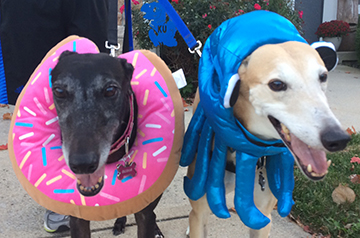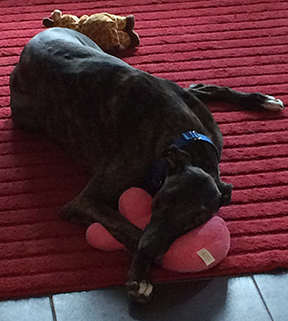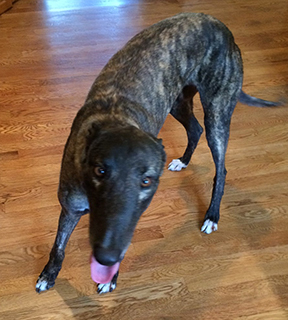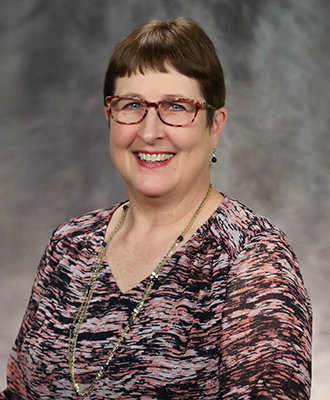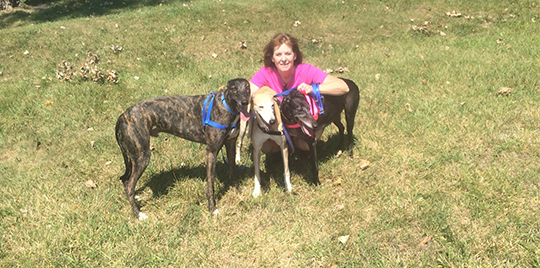
Public acceptance for greyhound racing has declined sharply over the years as news surfaced about improper animal treatment. Dogs viewed as too old or too slow are often no longer of value to owners. Thankfully, there are people like Radiology Supervisor Cheryl Bondank, RTR, and her husband Donald, an NKCH web designer, who rescue these gentle giants.
Seven years ago, Cheryl and Donald started volunteering with Kansas City Retired Greyhounds As Pets, or KCREGAP. Since 1990, the group has adopted out 5,000 greyhounds, including three to the Bondank home with a fourth dog adopted by another family after the Bondanks served as fosters.
Chili and Olivia, aged 10 ½, and the newest edition, two-year-old Thor, now live a different life. Thor has bonded with Cheryl and attaches to her side the minute she walks in. But, there’s little barking in this household. Ironically, greyhounds don’t typically bark, but make a “roo” sound, according to Cheryl.
A Different Life
During their racing days, greyhounds live in kennels with no access to toys and little human contact or affection. “In the industry, dogs are often killed when they can no longer race,” Cheryl explained. “Now, our dogs get a fenced yard with plenty of space for them to wander and enjoy their lives.”
The Bondanks also make accommodations for the dogs with taller feeding bowls and no crating since so much of the dogs’ life involved confinement. They also watch how much the dog’s eat as they are ravenous eaters who may overeat and become ill.
Another result from their racing days is they often chase anything they see, which makes it difficult to let them off leash. “These dogs are bred for racing and chasing that mechanical lure around the track,” Cheryl explained. “It’s very easy for them to run so far that they get lost.”
One myth Cheryl dispels is that greyhounds require more exercise than other breeds. Cheryl said because they have no body fat, the dogs can’t regulate their body temperature and can easily overheat, which can be fatal. “Our dogs go out to do a few laps and come back in. I call them my 40-mile-an-hour couch potatoes,” Cheryl said. Many of the dogs who raced, liked Olivia, suffer from arthritis, so their mobility is limited.
Tattoos and Art
Adopters can learn the history of their racing dogs from tattoos in their ears. The tattoo provides a number that can be traced to the dog’s lineage; indicate the dog’s racing history; identify how many litters for females; reveal the dog’s birth order; establish the dog’s original location and more.
Their dog Chili doesn’t have a tattoo because he was born before The Woodland’s race track closed in 2008. Kept in a barn with his two siblings, Cheryl remembers he was somewhat feral when he came into the KCREGAP program.
Cheryl loves seeing greyhounds depicted as the good natured animals that they truly are in real life. One of her favorite artists is Richard Skipworth, who also loves greyhounds. The dogs serve as the inspiration for many of his illustrations.
Always an animal lover, Cheryl thought of becoming a vet at one time, but she knew she couldn’t effectively help them when they are injured. She remembers as a child becoming upset when Bambi was hurt in the Disney classic. “I see an injured animal and I almost lose my mind, but I have no problem keeping it together when I take care of people,” Cheryl laughed.
Animal Lovers Wanted
Cheryl encourages others to become involved with KCREGAP as either a foster or volunteer.
KCREGAP’s foster families are extremely important to the success of their adoption program. The families give the greyhounds a chance to experience life in a home, which makes their transition to a forever home much easier. The organization always needs foster families. More foster families means more greyhounds can join the KCREGAP program.
The requirements for foster families are the same as those for adoption, including:
- completing KCREGAP’s adoption application
- home visit process
- owning a greyhound for at least 6 months, or
- experience with the sighthound breed (Whippets, Basenjis, Afghan Hounds, etc.)
The group then asks anyone interested to attend the foster training class held several times per year.
